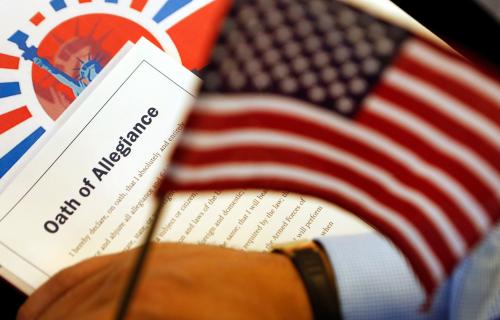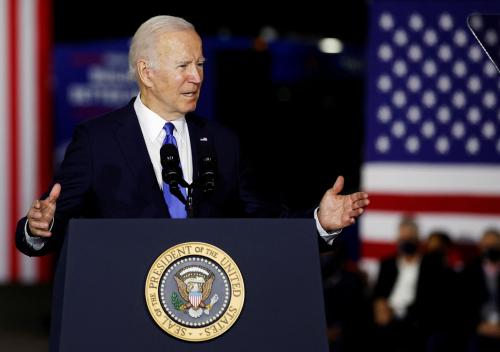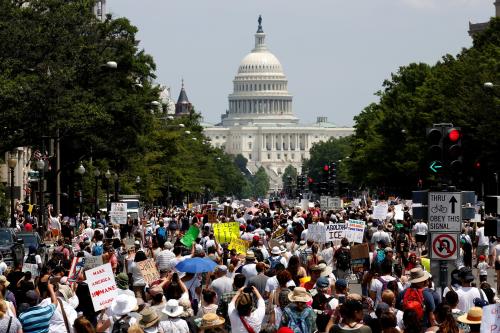On his very first day in office the new President Biden sent a comprehensive immigration bill to Congress to fulfill one of his major campaign promises. Will it work this time? A short look back at history shows just how difficult immigration reform can be. There have been two attempts at comprehensive immigration reform in the 21st century: one in 2007 and one in 2013. In both instances the political environment started out looking promising, and in both instances the legislation failed.
In 2006 there was every reason to be optimistic about the prospects for immigration reform. President George W. Bush was in his second term and thus had nothing to fear from a far-right challenge for his party’s nomination. In addition, as a former governor of Texas, he had great familiarity with the issue and wanted very much to do something about it. He had bipartisan support in the Senate from two of its most revered members: Sen. John McCain (R-AZ) and Sen. Ted Kennedy (D-MA). In the 2006 elections, Democrats took control and Rep. Nancy Pelosi (CA) became the first woman speaker of the House. There was reason to assume that a strong, bipartisan coalition could be put together in favor of a comprehensive bill.
But that coalition never happened.
In the winter and spring of 2006 pro-immigration reform groups, many of them Mexican-American political action organizations, decided that they could help the prospect of the Comprehensive Immigration Reform Act by organizing a series of high-profile national marches. Not content with the fact that President George W. Bush and most of the liberals in the Senate, including Senator Ted Kennedy, were planning to work together on a bipartisan bill, organizers assumed that bringing the fight out of Washington and to the country would help their cause.
All through the spring of 2006 organizers put together mega-events. A march in Chicago drew 100,000 marchers. It was followed by demonstrations in Tampa, Houston, Dallas and even Salt Lake City. The biggest demonstration of all took place in Los Angeles on March 25, 2006, when more than 500,000 people marched and attended rallies at the Civic Center and in MacArthur Park. Even more marches took place on May Day (May 1) a day otherwise known as International Workers’ Day—a traditional time of demonstrations for trade unions and other left-wing political causes.
The marches were widely covered by a mostly favorable media. Marchers waved American flags (some upside down—which can be a sign of distress or of disrespect) and Mexican flags. Signs were in Spanish and English—“Si se puede” was a popular one, as was “Today we march, tomorrow we vote.” In both breadth and enthusiasm, these marches evoked the large civil rights demonstrations of the 1960s.
However, the consensus immediately after the fact was that the demonstrations backfired. Even though organizers had tried to get marchers to leave the Mexican flags at home, their argument was only partially successful against arguments about ethnic pride. The Federation for American Immigration Reform, an anti-immigration group, saw its membership increase. Members of Congress felt the backlash. Republican lawmakers saw their offices flooded with phone calls as a result of the marches. Senator Trent Lott (R-MS) said “They lost me, when I saw so many Mexican flags.”[1] “The size and magnitude of the demonstrations had some kind of backfire effect,” said John McLoughlin, a Republican pollster working for House members and Senators seeking re-election.
With a large chunk of the Republican Party energized by their nativist base to oppose the 2007 bill, President Bush needed solid Democratic support. But the Democrats had their own factional problems. In April 2006 the Chairman of the Democratic National Committee, Howard Dean, referred to the guest worker provisions in the bill as “indentured servitude.” And AFL-CIO President John Sweeny openly opposed the guest worker provisions as well. Opposition came from Black lawmakers too. Speaking on National Public Radio, political scientist Ron Walters pointed “to the response of the Congressional Black Caucus to a liberal immigration bill produced by one of its own members, Sheila Jackson Lee of Texas. Only 9 of the 43 caucus members supported it.”
The factional divides among House Democrats were present among Democratic voters as well. A 2005 Pew poll asked Democrats questions about immigration and divided them into liberals, conservatives and disadvantaged democrats (referring to economic disadvantage). Note the stark differences between liberals and both disadvantaged Democrats and conservatives.
Table 1: “Other Fissures in the Democratic Coalition” (Source: Pew Research Center)
| Liberals | Disadvantaged Democrats | Conservative Democrats | |
| The growing number of newcomers from other countries… | |||
| Threatens traditional American customs and values | 9% | 53% | 53% |
| Strengthens American society | 87% | 34% | 35% |
| Neither/Both/Don’t Know | 4% | 13% | 12% |
The immigration bill died in the summer of 2007 when proponents failed to garner the 60 votes in the Senate required to move the bill forward. And in the House, Speaker Pelosi needed 50 to 70 Republican votes to move forward but a resolution in the Republican conference opposing the Senate bill passed by 114 to 21. She decided not to bring it to the floor.
It took six years before a second comprehensive immigration bill was introduced into Congress. As in 2007, many political experts thought that this time the stars were aligned. Democrats had picked up seats in the Senate in the 2012 elections that gave them a comfortable majority. And Democratic President Barack Obama had won a second term in office with a strong backing from Hispanic voters, leading national Republicans to discuss the need to deal with immigration in the face of the growing Hispanic vote. While Republicans still controlled the House, Democrats had picked up seats. On June 27, 2013, Senate bill 744, a second comprehensive immigration bill, passed the Senate on a 68 to 32 vote. The bill had been created by a bipartisan “gang of 8” – four Democratic senators and four Republican senators—and its passage created the expectation that there would be quick action in the House as well.[2]
Contributing to this optimism was the fact that this time around the Democratic coalition was less divided. In the six years since failure of the 2007 legislation, the labor movement had changed and included many more Hispanics in its membership. Rick Trumka, President of the AFL-CIO had this to say about the new legislation:
“Our role is to make sure that road map leads to citizenship achievable not only in theory but in fact. Workers care for the elderly, mow our lawns or drive our taxis, work hard and deserve a reliable road map to citizenship. And so the labor movement’s entire grassroots structure will be mobilized throughout this process and across this country to make sure the road map is inclusive.”
The Congressional Black Caucus was a bit less enthusiastic but still expressed support for the effort while complaining that the Diversity Visa Program had been eliminated.[3] And the U.S. Chamber of Commerce and the agricultural lobby were on board as well.
Meanwhile, the Obama administration had continued efforts begun during the Bush administration to prove that the United States could police the borders. In 2013 federal prosecutions for immigration crimes reached an all-time high.
But Obama’s get-tough actions at the border infuriated Hispanic activists and failed to convince some Republicans that the border was under control.
If the factions of the Democratic Party had softened in the years between 2007 and 2013, the factions in the Republican Party had hardened. In 2013, Speaker John Boehner was facing significant intra-party infighting, largely due to the growing voice of the Tea Party activists in his conference—a group that would contribute to his historic resignation just two years later. To please the hard-liners in his party he rejected the Senate bill in favor of a series of smaller bills and then, when suspicion was that these smaller bills would go to conference with the hated Senate bill, he had to promise not to compromise.
And then, as is so often the case in politics, something happened that on the face of it had nothing to do with immigration reform but that killed it nonetheless. Majority Leader Eric Cantor, widely expected to succeed Boehner as speaker, lost his Republican primary to a right-wing tea party supporter who among other things campaigned on opposition to immigration reform. Republicans were spooked by Cantor’s loss. If a member of the leadership could lose to an unknown Tea Party challenger, they could too. Boehner never brought the legislation to the floor, in spite of the fact that it probably could have passed with a united Democratic caucus and some more moderate business-oriented Republicans.
What will happen this time around is anyone’s guess. Immigration reform has always had a way of eluding the best-laid plans of powerful people. The Republican Party is still in limbo, with many members clearly anti-immigrant and others fearful of an anti-immigrant primary electorate. While Democrats are less divided than Republicans, their margins are so small that they can’t afford to lose anyone.
Immigration reform may be as difficult in the third decade of the 21st century as it was in the first and second. This is in part because of a fundamental paradox. On the one hand, the United States is a country of immigrants; on the other hand, it is a country that has always been worried about being overrun by immigrants. And this makes reform especially difficult.
[1] Otis L. Graham Jr. Immigration Reform and America’s Unchosen Future (Bloomington Indiana, Author House 2008), page 437.
[2] The Democrats were: Michael Bennett (CO) Dick Durbin (ILL) Bob Menendez (NJ) and Chuck Schumer (NY). The Republicans were: Lindsey Graham (South Carolina), Jeff Flake (AZ) John McCain (AZ) and Marco Rubio (FLA)
[3] The Diversity Visa Program is a lottery for obtaining a green card to work in the United States.







Commentary
Can Biden pass immigration reform? History says it will be tough
June 22, 2021